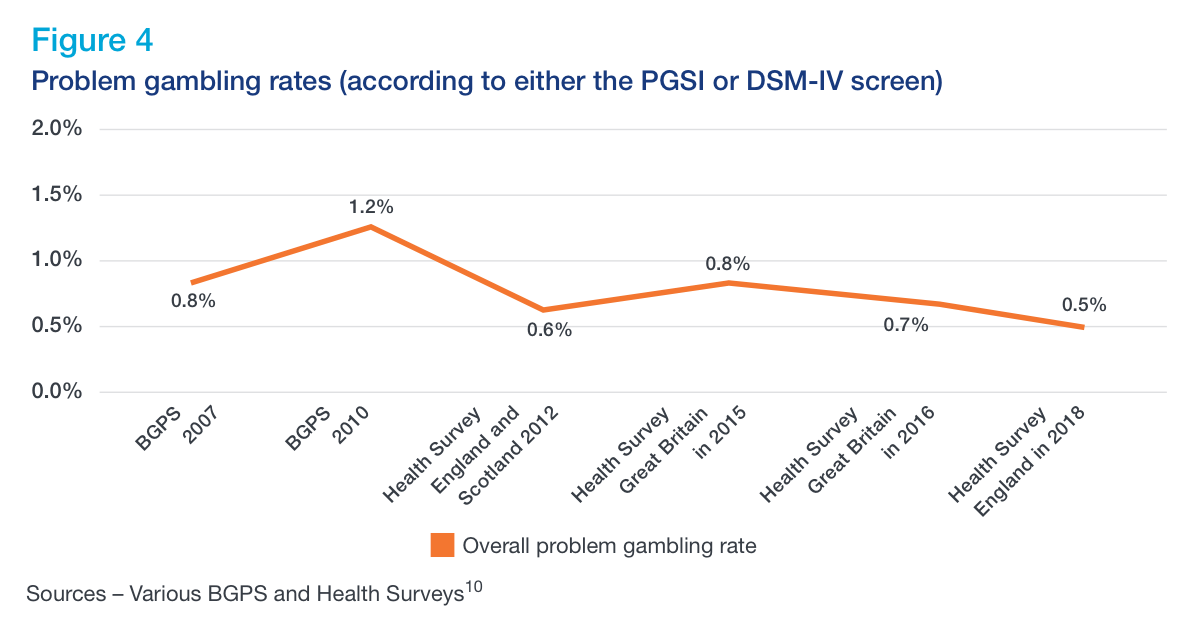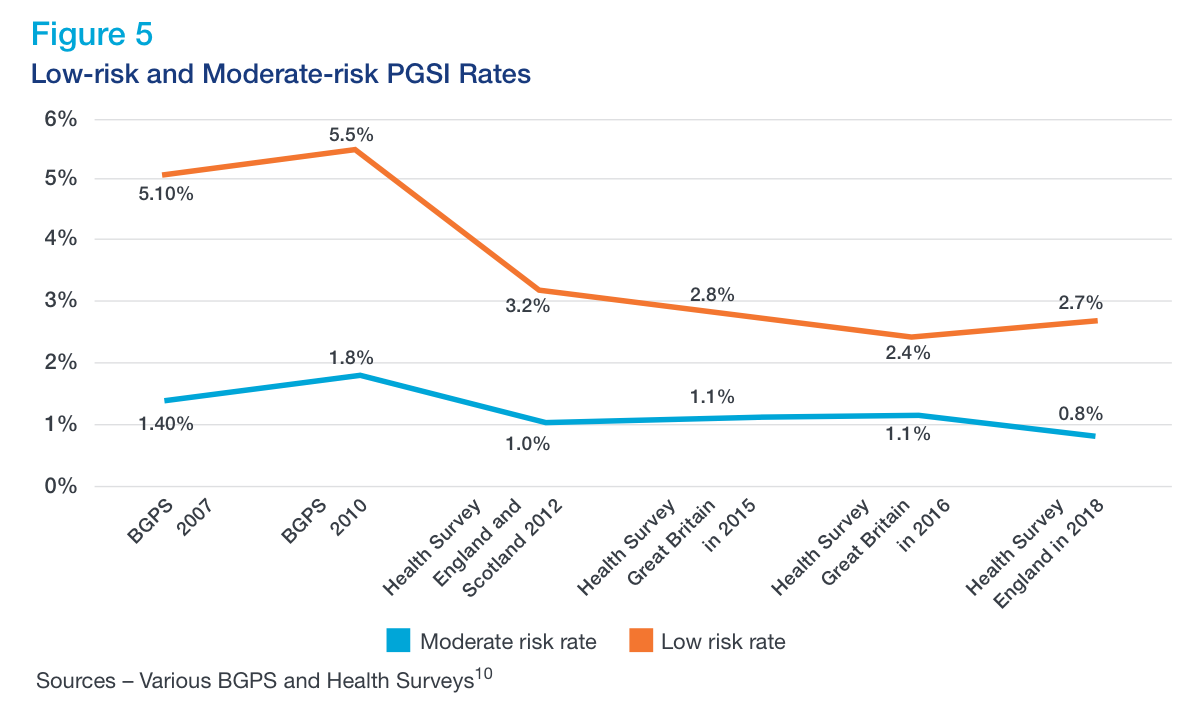Strategy
National Strategic Assessment 2020
This report sets out our latest assessment of the issues we face and the risks that gambling poses to consumers and the public
Problem and at-risk gambling
Problem gambling rates are not increasing. Figure 4 sets out problem gambling rates from the best available survey data 6. The data indicates that the overall rate of problem gambling has been statistically stable since 2012 as defined by either the Problem Gambling Severity Index (PGSI) or Diagnostic and Statistical Manual of Mental Disorders (DSM-IV) screens. Our latest annual telephone survey7 suggests 0.6% of the population are classified as problem gamblers8 compared with 0.7% in 2016.
In any event, according to the combined England, Scotland and Wales ‘Gambling behaviour in Great Britain 2016’ data there are approximately 340,000 problem gamblers in Great Britain9. That is simply unacceptable and, as we have repeatedly made clear, needs to be drastically reduced.

Whilst our data suggests that the problem gambling rate is broadly stable, the data on at-risk rates suggests that progress is being made to reduce the numbers of people at low or moderate risk. Figure 5 sets out the relevant data 11.

Whilst the data suggests that the proportion of people at moderate or low risk of harm has reduced, we need to see those numbers decline further.
The majority of people who gamble do so without experiencing harm. But too many people get into difficulty as a result of gambling and can experience very significant harms, including mental health and relationship problems, debts that cannot be repaid, crime and suicide in extreme cases12. The fact that problem gambling rates have been broadly stable since 2012, does not alter the fact that more needs to be done to understand how gambling related harm can be reduced with actions implemented to achieve a significant reduction. The National Strategy to Reduce Gambling Harms provides an agreed framework for action.
Understanding the prevalence and causes of problem gambling is not straightforward; it is constantly changing as individuals who have experienced gambling harms recover and other people become problem gamblers (due to the onset of problem gambling behaviour or relapses). We need to understand why people become problem gamblers, why some people recover and why some who recover relapse.
To do this we need to understand the incidence rate (new cases occurring over time) and the number of people who relapse. Understanding the incidence rates will inform whether more effort needs to be put into prevention measures (for new cases of problem gambling) or treatment (for those who are relapsing).
Longitudinal studies in Australia show that about half of the prevalence rate is made up of new cases, meaning new people are being classified as problem gamblers at each survey point and that means some people have moved out of problematic gambling 13. Equivalent UK data would be a valuable addition to the available evidence base.
It is important to note that focussing on percentages across the total population risks overlooking issues within specific groups such as women or BAME communities. Figure 6 breaks down the data to present the number of at risk or problem gamblers if the world were 100 British adults. More than half of those adults do not gamble, and half a person is a problem gambler. The figure is then broken down into different scenarios to demonstrate some the key demographic risks associated with the person gambling.





References
6Information about the PGSI and DSM-IV screens
7Gambling participation in 2019 behaviour awareness and attitudes
8 According to the PGSI mini-screen
9Gambling behaviour in Great Britain (opens in new tab)(PDF)This is the most recent Health Survey data we have for the whole of Great Britain. More recent data has been released from the Health Survey England 2018 and Wales Problem Gambling Survey 2018 but this is not reflective of the whole of Great Britain.
10 Please note that a different methodology was used for BGPS, so care should be taken making comparisons between these survey vehicles.
11The Problem Gambling Severity Index uses the following definitions:
- problem gambling – gamble with negative consequences and a possible loss of control. For example, they may often spend over their limit, gamble to win back money and feel stressed about their gambling
- moderate-risk gamblers – experience a moderate level of problems leading to some negative consequences. For example, they may sometimes spend more than they can afford, lose track of time or feel guilty about their gambling
- low-risk gamblers – experience a low level of problems with few or no identified negative consequences. For example, they may very occasionally spend over their limit or feel guilty about their gambling.
12Measuring gambling-related harms: A framework for action, Wardle and Reith et al (2018)
14For the purposes of this illustration, figures have been rounded up or down, to the nearest 0.5, to ensure that figures sum to 100.
15Participate in four or more different gambling activities.
Understanding why people gamble Next section
The person gambling - What are the issues?
Last updated: 11 November 2022
Show updates to this content
Following an audit links to Information about the PGSI and DSM-IV screens, Gambling participation in 2019 behaviour awareness and attitudes, Gambling behaviour in Great Britain and the Victorian Gambling Study have been updated.
